ASUS P8Z68-V PRO Review: Our First Z68 Motherboard
by Ian Cutress on May 11, 2011 3:13 AM EST- Posted in
- Motherboards
- Asus
- Z68
3D Movement Algorithm Test
The first benchmark ran is actually one I have written. My full time job involves computational chemistry, so this first benchmark uses various algorithms for three-dimensional simulation and movement of independent particles. The algorithms both employ uniform random number generation or normal distribution random number generation, and vary in various amounts of trigonometric operations, conditional statements, generation and rejection, fused operations, etc. The benchmark runs through six algorithms for a specified number of particles and steps, and calculates the speed of each algorithm, then sums them all for a final score. This is an example of a real world situation that a computational scientist may find themselves in, rather than a pure synthetic benchmark. The benchmark is also parallel between particles simulated, and we test the single thread performance as well as the multi-threaded performance.
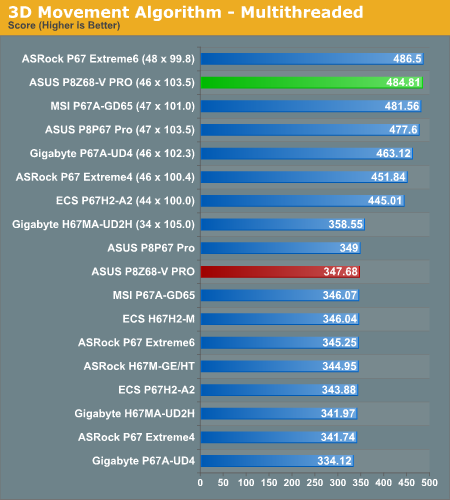
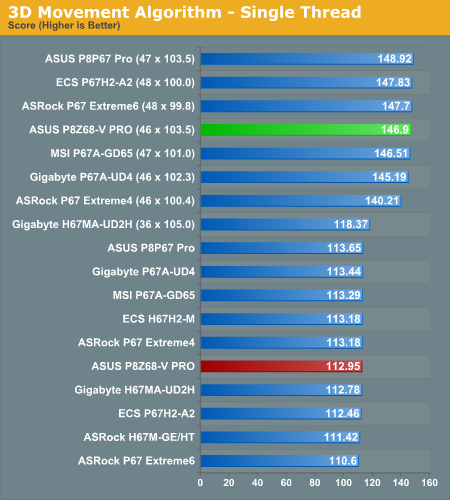
WinRAR x64 3.93
With 64-bit WinRAR, we compress the set of files used in the USB speed tests. WinRAR x64 3.93 attempts to use multithreading when possible.
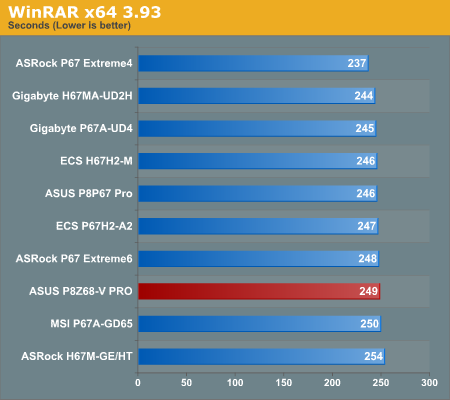
FastStone Image Viewer 4.2
FastStone Image Viewer is a free piece of software I have been using for quite a few years now. It allows quick viewing of flat images, as well as resizing, changing color depth, adding simple text or simple filters. It also has a bulk image conversion tool, which we use here. The software currently operates only in single-thread mode, which should change in later versions of the software. For this test, we convert a series of 170 files, of various resolutions, dimensions and types (of a total size of 163MB), all to the .gif format of 640x480 dimensions.
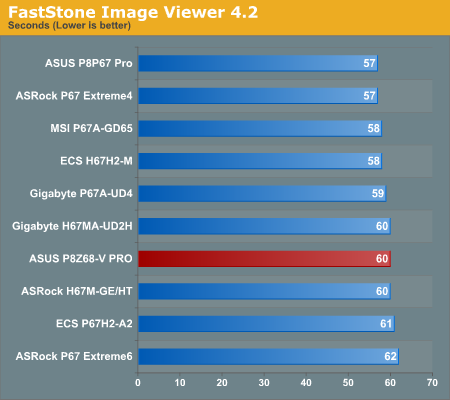
Sorenson Squeeze 6.0
Sorenson Squeeze is a professional video encoder, complete with a vast array of options. For this test, we convert 32 HD videos, each a minute long and approximately 42 MB in size, to WMV 512KBps format. Squeeze can encode multiple videos at once, one for each thread.
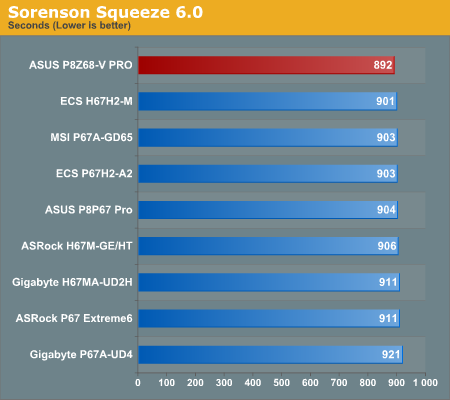
The ASUS does relatively well in our Computation bench suite, with an excellent Squeeze score. It's not the fastest board so far, but the difference between the slowest and fastest board in each test is only 3-9%, so for stock performance it's not something generally noticeable in day to day use.










95 Comments
View All Comments
Irakusa - Thursday, September 29, 2011 - link
Not really, you're just limiting your thinking a bit. The whole reason I fill datacenters with blade servers and then oversubscribe every resource I can is exactly the same as what NeBlackCat is applying in smaller scale with this line of inquiry.Servers big enough to run hundreds of VMs on demand, but also able to dynamically adjust power, cooling, cost, and wear and tear on components. It's a good thing.
What do you think Intuit does at tax time, build a few thousand new web servers (hoping they have enough) and then leave them sitting around afterward waiting for next year's tax season? No, the reallocate resources where they're needed.
HaryHr - Wednesday, May 11, 2011 - link
Thinking like this you could also say no point in overclocking, just buy Extreme Edition CPU... but that's just not the same.L. - Thursday, May 12, 2011 - link
No.Overclocking = more power for the same mullah
Downclocking = less power for the same mullah
Downclocking = less power/watts
Buying another chip = less mullah, less power, less watts
Basically downclocking is a practice that should disappear shortly as the spectrum of power consumption on available chips has become wide enough, along with low power chips being more than enough for everyone's tasks excluding gaming and extremely rare computational tasks.
shawngmc - Friday, May 13, 2011 - link
Absolutely untrue. I repurpose my hardware - though I buy a new core (CPU/MB/RAM) yearly, I reuse my parts, cycling them through my desktop, HTPC, server, and project PCs or for family members.When I move parts from one usage to another, my demands change. My HTPC should have decent performance but be cool and quiet. My server needs good CPU performance (I run services in VMs) but I prefer energy efficiency there as well. Only my main desktop should be a power-hungry monster.
I'm about to move my i7-930 to my home server. Even with the copious VMs, I probably don't need full clock speed from it. So, since it'll be on 24/7, I want it to be energy efficient. Underclocking? Say, not a bad idea!
NeBlackCat - Wednesday, May 11, 2011 - link
In your opinion. I thought it was supposed to be a general review of the board. This isn't a teenage gamer site - plenty of people are interested in Sandy Bridge/Z68 as a powerful, yet power efficient, platform. And, for many of them, it's useful to know how much you can undervolt while maintaining stock clock, and so on. Some of us like our HTPCs to run as cool and quietly as possible most of the time, for example. It doesn't hurt to cover both sides - a couple of paras covering this is all that's needed.L. - Thursday, May 12, 2011 - link
HTPC Sandy Bridge ?Seriously, if you don't understand hardware and it's use, please just avoid spreading your convictions.
There is no reason for an HTPC to sport anything even remotely as powerful as 1/4th of a Sandy Bridge chip.
We have reached a level in IT equipment where the chip in your mobile phone can almost cater for all of your HTPC / NAS needs so just face it, spend $300 less and get what you need instead of a 99.999999% idle overpowered CPU. Save the planet, green stuff, whatever !
NeBlackCat - Friday, May 13, 2011 - link
Perhaps you don't understand that an HTPC is a 3W Sigma/Realtec media streamer to some, an occasional media encoding powerhouse (as well) to others, and something close to both for an increasing number of people.Vendors increasingly provide idle frugality but performance on tap - in the OS/BIOS, in the chipset (eg. simultaneous clock override/IGP) , in the CPU (eg. turbo boost), in the graphics susbsystem (eg. Virtu, Optimus, etc) and so on.
And these features ARE there in Z68/Sandy Bridge. The question is why they ARE NOT all there in reviews.
PS - that phone able to do HTPC/NAS duties (HD high profile H264, simultaneous transcoding/streaming/recording/multichannel, etc) for $300 less than an entry level Sandy Bridge sounds extremely interesting.
Can you tell me where to by one? Because the tiny TrimSlice Tegra 2 box I've had sitting here for a week (at a cost of $330, which is not $300 short of Sandy Bridge territory) doesn't even get close. Not that I expected it to.
shawngmc - Friday, May 13, 2011 - link
Exactly. I should be able to play games on my HTPC on occasion! Hell, Lucid Vertu theoretically sounds like a great solution - stick a decent GPU in and play modern games - Crysis 2, Portal 2, etc - on my 55" screen? Yes, please.Hell, I'll get some use out of my 3DTV with Nvidia 3DTV Play, now that it's FINALLY available.
xinaes - Wednesday, May 11, 2011 - link
"This segment is made to get the maximum out of your rig and not vice versa."In Soviet Russia, your rig gets the most out of you.
Sorry, couldn't resist.
Glad to see so many other people on the side of not wantonly burning power and still considering the idea of having a reasonably powerful machine.
NeBlackCat - Wednesday, May 11, 2011 - link
I want to get the maximum performance at the maximum power saving out of my rig. ;-)